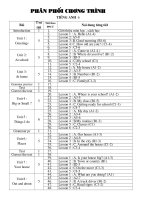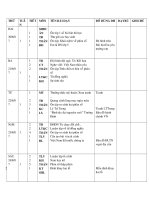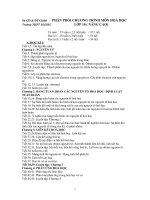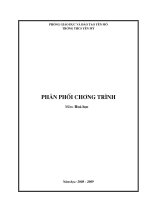- Trang chủ >>
- Mầm non - Tiểu học >>
- Lớp 5
Chương trình Hóa A level
Bạn đang xem bản rút gọn của tài liệu. Xem và tải ngay bản đầy đủ của tài liệu tại đây (1.08 MB, 16 trang )
<span class='text_page_counter'>(1)</span><div class='page_container' data-page=1>
<i>UNIT 1</i> 1page
<b>HCM CITY, VIETNAM 2016 </b>
<b>Welcome to </b>
</div>
<span class='text_page_counter'>(2)</span><div class='page_container' data-page=2>
<i>UNIT 1</i> 2page
The Atom
<i><b>What is an atom? </b></i>
Atoms are the smallest unit. They are the building blocks of matter.
Everything in the world is made of atom !
Atoms are too small in size : Size of Earth : Soda can = Soda can : Atom
<i><b>Atoms are made up of Protons, Neutrons and Electrons </b></i>
<b> The mass and charge of these subatomic particles is really small, so relative mass and </b>
<b>relative charge are used instead. </b>
1 unit of charge is 1.602 x 10 19 coulombs
1 unit of mass is 1.661 x 1027 kg
<i> The symbol and the charge of proton, neutron, electron </i>
<b>Atomic Structure</b> <b>Particle</b> <b>Symbol</b> <b>Actual charge/C</b> <b>Relative charge</b>
<b>Nucleus</b> proton p +1.60 x 10
19 <b><sub>1+ </sub></b>
neutron n <sub>0</sub> 0
<b>Electron cloud </b> electron e <sub>1.60 x 10</sub>19
1
<i> The mass of proton, neutron, electron </i>
<b>Atomic Structure</b> <b>Particle</b> <b>Symbol</b> <b>Actual mass/kg</b> <b>Relative mass</b>
<b>Nucleus</b> proton p 1.67 x 10
27 <sub>1 </sub>
neutron n <sub>1.67 x 10</sub>27 <sub>1 </sub>
<b>Electron cloud</b> electron e <sub>9.11 x 10</sub>31 0.00055 = <sub>2000</sub>
1
(which is usually ignored)
The mass of an electron is negligible compared to a prton or a neutron – this means you an
usually ignore it.
<b>1 </b>
a) <b>Draw a diagram showing the structure of the atom, labelling each part. </b>b) Where is the mass concentrated in an atom, and what makes up most of the volume of an
atom?
</div>
<span class='text_page_counter'>(3)</span><div class='page_container' data-page=3>
<i>UNIT 1</i> 3page
<i><b>NIELS BOHR and . . . model </b></i> <i><b> </b></i>
The shapes of s, p, d, f – orbitals
Niels Bohr proposed that the electrons aren’t on any random orbit around the
nucleus, they are on “special” orbits. The size and shape of an orbital is drawn so
that there is a 90% probability of finding the electron within its boundary.
<i><b>Atomic (Nuclear) Symbols show Numbers of Subatomic Particles </b></i>
<b>The atomic number (Z) of an element (on the periodic table) is the number of protons = the </b>
<b>number of electrons in a neutral atom (an atom with zero charge). </b>
<b>The mass number (A) is the sum of the number of protons and neutrons in the nucleus. </b>
Number of neutrons = A – Z
2
Nuclear
symbol
Atomic
number, Z
Mass
number, A
Protons Electrons Neutrons
7
3Li 7 – 3 = 4
24
12Mg
80
35Br
<b>3 </b>
Identify the particle that has 13 protons, 14 neutrons and 10 electrons.<i>[ASChemistry/page39] </i>
</div>
<span class='text_page_counter'>(4)</span><div class='page_container' data-page=4>
<i>UNIT 1</i> 4page
<b>4 </b>
Use the periodic table to write symbols for the following species:a) 19 protons, 20 neutrons, 18 electrons.
b) 8 protons, 8 neutrons, 10 electrons.
c) 1 proton, 2 neutrons, 1 electron.
d) 82 protons, 126 neutrons, 80 electrons.
e) 53 protons, 74 neutrons, 54 electrons.
<i><b>Isotopes of An Element are atoms with the Same Number of Protons (atomic number - Z) but Different </b></i>
<i><b>Numbers of Neutrons (mass numbers - A). </b></i>
<b>5 </b>
<b>Here’s another example: magnesium (atomic number 12), oxygen (atomic number 8) has </b>3 naturally occurring isotopes.
<i>Mg</i>
24
12 (79%) : 12 protons, 12 electrons, . . . neutrons
<i>Mg</i>
25
12 (10%) : 12 protons, 12 electrons, . . . neutrons
<i>Mg</i>
26
12 (11%) : 12 protons, 12 electrons, . . . neutrons
<i>O</i>
16
8 (99.76%) : . . . protons, . . . electrons, . . . neutrons
<i>O</i>
17
8 (0.04%) : . . . protons, . . . electrons, . . . neutrons
<i>O</i>
18
8 (0.20%) : . . . protons, . . . electrons, . . . neutrons
<b>6 </b>
Hydrogen, deuterium and tritium are all isotopes of each other.a) Identify one similarity and one difference between these isotopes. [2 marks]
b) Deuterium can be written as 2H. Determine the number of protons, neutrons and electrons in
neutral deuterium. [3 marks]
</div>
<span class='text_page_counter'>(5)</span><div class='page_container' data-page=5>
<i>UNIT 1</i> 5page
<i><b>Calculating Relative Atomic Mass of An Element (A</b><b>r</b><b>) </b></i>
The relative atomic mass can be calculated by the formula:
Ar = Σ (perentage abundance of each isotope x relative mass of each isotope)
100
<b>7 </b>
Lithium has two isotopee, 6Li and 7Li. Use the date below to calculate the relative atomic<i>mass of lithium. [ASChemistry/page20] </i>
Isotope Relative isotopic mass
m/e % abundance
6
Li 6.015 7.42
7
Li 7.016 92.58
<b>8 </b>
Use the following isotpic abundance data for Ar and Mg to calculate their relative atomicmass (Ar)
Isotope 40
18Ar
36
18Ar
38
18Ar
Relative abundance (%) 99.60 0.34 0.06
Isotope 24Mg 25Mg 26Mg
Relative abundance (%) 78.99 10.00 11.01
<b>9 </b>
Use the following isotpic abundance data for Ni to calculate their relative atomic mass (Ar)Isotope 58
28Ni
60
28Ni
61
28Ni
62
28Ni
64
28Ni
Relative abundance (%) 68.27% 26.10% 1.13% 3.59% 0.91%
<b>10 </b>
The relative atomic mass of copper is 63.5. Calculate the relative abundance of the<i>two copper isotopes with relative isotopic masses of 63.0 and 65.0. [ASChemistry/page39] </i>
</div>
<span class='text_page_counter'>(6)</span><div class='page_container' data-page=6>
<i>UNIT 1</i> 6page
E.g.
<i>Br</i>
35 The 1 charge means that there’s . . . more electron than there are
protons. Br has . . . . protons, so Br must have . . . . electrons.
The overall charge = +. . . . . . = . . .
<b> Positive ions have fewer electrons than protons </b>
E.g.
2
12
<i>Mg</i>
The 2+ charge means that there’s . . . fewer electrons than there areprotons. Mg has . . . . protons, so Mg2+<sub> must have . . . . electrons. </sub>
The overall charge = +. . . . . . = . . .
11
<i>Na</i>
23
11
<sub>:</sub> <sub>. . . protons, . . . electrons, . . . neutrons </sub>
2
24
12<i>Mg</i> : . . . protons , . . . electrons, . . . neutrons
<i>Mg</i>
24
12
: . . . protons, . . . electrons, . . . neutrons
3
27
13<i>Al</i> <sub>:</sub> . . . protons, . . . electrons, . . . neutrons
<i>Cl</i>
35
17
<sub>: </sub> <sub>. . . protons, . . . electrons, . . . neutrons</sub>
<i>Cl</i>
37
17
: . . . protons, . . . electrons, . . . neutrons
2
16
8<i>O</i>
: . . . protons, . . . electrons, . . . neutrons
2
17
8<i>O</i> : . . . protons, . . . electrons, . . . neutrons
3
14
7<i>N</i>
: . . . protons, . . . electrons, . . . neutrons
<b>12 </b>
Potassium was first isolated by Sir Humphrey Davy in 1807. It has two main isotopes,39
K and 41K. Both isotopes are able to form a positive ion with a single charge.
Complete the table below.
Particle Number of
protons
Number of
neutrons
Number of
electrons
39
K <sub>. . . </sub> <sub>. . . </sub> <sub>. . . </sub>
41
K+ <sub>. . . </sub> <sub>. . . </sub> <sub>. . . </sub>
<b>13 </b>
Deduce the number of protons, neutrons and electrons in the following species:1
1H
14
6C
17
8O
132
54Xe
235
92U
4
2He
2+ 27
31Al
3+
11H
+ 45
21Sc
3+ 37
17Cl
3216S
2 15
7N
</div>
<span class='text_page_counter'>(7)</span><div class='page_container' data-page=7>
<i>UNIT 1</i> 7page
<b>14 </b>
Study the table below and answer the queations that follow.a) Identify the two elements of A – F that are isotopes.
b) Identify which of A – F are neutral atoms.
c) Identify which of A – F are cations.
d) Identify which of A – F are anions.
<i>e) Identify which of A – F have the same electron configuration. [ASChemistry/page39] </i>
Element Number of protons Number of neutrons Number of electrons
A
B
C
D
E
F
19
17
12
17
35
18
20
18
12
20
44
22
18
17
10
16
36
18
<b>15 </b>
This question relates to the atoms or ions A to D:A. 3216S
2
, B. 4018Ar, C.
30
16S, D.
42
20Ca.
a) Identify the similarity for each of the following pairs, justifying your answer in each case.
(i) A and B. [2 marks]
(ii) A and C. [2 marks]
(iii) B and D. [2 marks]
b) Which two of the atoms or ions are isotopes of each other? Explain your reasoning. [2 marks]
<b>Atoms and Moles</b>
<i><b>Relative Masses are Masses Compared to Carbon – 12 </b></i>
The mass of 12
C = 1.661 x 1027<i> kg </i>
E.g: A natural sample of chlorine contains a mixture of 35
Cl (75%) and 37<i>Cl (25%), so </i>
<i><b>- The Relative isotopic mass are 35 and 37 </b></i>
<b>- The Relative atomic mass, Ar</b><i><b> is 35.5 (the average mass of an atom of an element) </b></i>
<b> E.g: The Relative molecular mass, Mr</b> (H2O) = (2x1) + 16 = 18
<i><b>A Mole is just a Very Large Number of Particles </b></i>
<b> One mole is roughly 6 x 1023</b>
<b> particles (the Avogadro constant, L) </b>
Number of moles = <sub>23</sub>
10
<i>6 x</i>
<i>have</i>
<i>you</i>
<i>particles</i>
<i>of</i>
<i>Number</i>
<i> Example: I have 1.5x10</i>24
</div>
<span class='text_page_counter'>(8)</span><div class='page_container' data-page=8>
<i>UNIT 1</i> 8page
Number of moles =
23
24
10
6
10
5
.
1
<i>x</i>
<i>x</i>
2.5 moles
<i><b>Molar Mass (M) is the Mass of One Mole of something </b></i>
<b> Molar mass is just the same as the relative mass (the only difference is you stick a “g mol-1</b><sub>” </sub>
<i>for grams per mole on the end </i>
<i>Example: Find the molar mass of CaCO</i>3<i>? </i>
- Mr of CaCO3<i> = 40 + 12 + (3 x 16) = 100 </i>
- So the molar mass, M, is 100 g mol – 1 (1 mole of CaCO3<i> weighs 100 gam) </i>
Number of moles =
<i>M</i>
<i>ce</i>
<i>subs</i>
<i>of</i>
<i>Mass</i> tan
<i>Example: How many moles of aluminium oxide are present in 1.5 gam of Al</i>2O3?
- M of Al2O3 = (2 x 27) + (3 x 16) = 102 g mol – 1
- Number of moles of Al2O3 = <sub>1</sub>
102
1
.
5
<i>mol</i>
<i>g</i>
<i>g</i>
= 0.05 moles
<i>Worked example: </i>0.0222 mol of an oxide of sulfur has a mass of 1.42 g. Calculate its molar
mass.
- Molar mass of the sulfur oxide
Moles and mass to identity
<i><b>Worked example: </b></i>0.0250 mol of a group 2 sulfate has a mass of 4.60 g. Calculate the molar
mass of the sulfate and hence identify the group 2 metal ion in the compound.
<i>Answer </i>
- Molar mass
-The formula of group 2 sulfates is of the form MSO4, where M represents the group 2
metal. Of the 184 g mol1, 32.1 + (4x16.0) = 96.1 g comes from the SO4 group.
Therefore, the molar mass of the group 2 metal = 184 g mol 1 – 96.1 g mol 1 = 87.9 g
mol 1
- From the periodic table, the group 2 metal that has a molar mass nearest to 87.9 g mol 1
<b>is strontium, Sr. </b>
<i>Worked example: </i>0.100 mol of hydrated sodium carbonate, Na2CO3.xH2O, has a mass of 28.6
g. Calculate its molar mass and hence the number of molecules of water of crystallisation.
<i>Answer </i>
- Molar mass of Na2CO3.xH2O
- Mass of Na2CO3 = (2x23)+12.0+(3x16.0) = 106.0 g
- Mass of water = 286 – 106 = 180 g
- There are 180 g of water in 1 mol of the hydrated solit
- Mmount (moles) of water
- The number of molecules of water of crystallisation is 10.
<i>moles</i>
<i>mass</i>
1
0
.
64
0222
.
0
42
.
1 <sub></sub>
<i>g</i> <i>mol</i>
<i>mol</i>
<i>g</i>
1
184
0250
.
0
60
.
4 <sub></sub> <sub></sub>
<i>g</i> <i>mol</i>
<i>mol</i>
<i>g</i>
<i>moles</i>
<i>mass</i>
1
286
100
.
0
6
.
28 <sub></sub>
<i>g</i> <i>mol</i>
</div>
<span class='text_page_counter'>(9)</span><div class='page_container' data-page=9>
<i>UNIT 1</i> 9page
<i><b>One mole of any Gas always has the Same Volume (if Temperature and Pressure stay </b></i>
<i><b>the Sam) </b></i>
<b> At room temperature and pressure (r.t.p is 298 K (25 </b>0
C) and 101.3 kPa), this happens to be
<b>24 dm3</b>
Number of moles =
24
000
24
3
3
<i>dm</i>
<i>in</i>
<i>Volume</i>
<i>cm</i>
<i>in</i>
<i>Volume</i>
<b> </b>
<i>Example: How many moles are there in 6 dm</i>3 of oxygen gas at r.t.p?
Number of moles =
24
6
= 0.25 moles of oxygen molecules
<i><b>The Concentration of a Solution is how may moles are dissolved per 1 dm</b></i>
<i>3</i><i><b> of solution. </b></i>
<i><b>The units are mol dm</b></i>
<i><b> – 3</b></i><i><b> </b></i>
Number of moles =
1000
)
(
)
(
3
3 <i>ConcentrationxVolume</i> <i>incm</i>
<i>dm</i>
<i>in</i>
<i>Volume</i>
<i>x</i>
<i>ion</i>
<i>Concentrat</i>
<i> Example: What mass of sodium hydroxide needs to be dissolved in 50 cm</i>3
of water to make a
2 mol dm – 3 solution?
- Number of moles =
1000
50
<i>2x</i>
<b>0.1 moles of NaOH </b>
- M of NaOH = 23 + 16 + 1 = 40 g mol – 1
<b>- Mass = number of moles x M = 0.1 x 40 = 4 g </b>
<i><b>Parts Per Million is used for Really Small Quantities </b></i>
<b> Xenon makes up only 0.000 009% of the atmosphere. Numbers this small are a pain to work </b>
with
<b> So if there’s 0.000 009 parts of Xe in every one hundred parts of air, you can multiply both </b>
<b>quantities by 10 000 to make the quantity large enough to work with, like this: </b>
0.000 009% = <i>parts</i> <i>per</i> <i>million</i>
<i>x</i>
<i>x</i>
09
.
0
000
000
1
09
.
0
000
10
100
000
10
009
000
.
0
100
009
000
.
0 <sub></sub> <sub></sub> <sub></sub>
<b>So there’s 0,09 ppm xenon. The atmosphere also contains 0.01 ppm carbon and 0.3 ppm </b>
nitrous oxide.
Question
16
<i><b>1. Calculate the amount (in moles) of water in 4.56 g. </b></i>
<i><b>2. Calculate the amount (in moles) of calcium chloride, CaCl</b></i>2 in 7.89 g.
<i><b>3. Calculate the amount (in moles) of sucrose, C</b></i>12H22O11 in 3.21 g. The molar mass of sucrose is 342.0
g mol1.
<i><b>4. Calculate the amount (in moles) of 1.11 g of calcium carbonate, CaCO</b></i>3.
<i><b>5. Calculate the amount (in moles) of 2.22 g of barium hydroxide, Ba(OH)</b></i>2.
</div>
<span class='text_page_counter'>(10)</span><div class='page_container' data-page=10>
<i>UNIT 1</i> 10page
Question
<b> 17 </b>
Calculate the mass of substance present in the following cases:a) 100 mol of sodium metal.
b) 0.05 moles of Cl2
c) 250 moles of Fe2O3
d) 0.0333 mol of sulfuric acid, H2SO4.
e) 0.36 moles of ethanoic acid, CH3COOH. [2 marks]
f) What mass of H2SO4 is needed to produce 60 cm3 of a 0.25 mol dm – 3 solution? [2 marks]
Question
18
<i><b>1. 0.0500 mol of an organic acid had a mass of 3.00 g. Calculate the molar mass of the acid. </b></i>
<i>ASChemistry. page 57 </i>
<i><b>2. Calculate the relative molecular mass of the following substances and suggest a possible identity of </b></i>
each substance:
a) 0.015 moles, 0.42 g c) 0.55 moles, 88 g b) 0.0125 moles, 0.50 g
d) 2.25 moles, 63 g e) 0.00125 moles, 0.312 g
Question
19
<i><b>1. Calculate the number of: </b></i>
a) molecules in 1.2 mol of water ; in 1.2 g of water.
b) nitrogen atoms in 100 g of N2.
c) oxygen atoms in 0.0100 mol of carbon dioxide, CO2.
d) molecules in 3.33 g of methane, CH4 (molar mass = 16.0 g mol – 1 ).
e) sodium ions in 2.22 g of sodium sulfate, Na2SO4 (molar mass = 142.1 g mol – 1).
f) hydroxide ions in 10.0 g of barium hydroxide.
<i><b>2. Calculate the mass of the following substances: </b></i>
a) 2.5 x 1023 molecules of N2 b) 1.5 x 1024 molecules of CO2 c) 2 x 1020 atoms of Mg
<i><b>3. Calculate: </b></i>
a) the number of atoms in 1 mol of CO2
b) the number of chloride ions in 1 mol of calcium chloride, CaCl2
</div>
<span class='text_page_counter'>(11)</span><div class='page_container' data-page=11>
<i>UNIT 1</i> 11page
Question
<b> 20 </b>
0.0185 mol of hydrated magnesium sulfate, MgSO4.xH2O, has a mass of4.56 g. Calculate the number of molecules of water of crystallisation in the hydrated salt.
<i>[ASChemistry/page60] </i>
<b>Empirical and </b>
Molecular Formulas
<b>The Empirical formula </b>
<i><b>gives the smallest whole number ratio of atoms in </b></i>
a molecule.
<b>The Molecular formula </b>
<i><b> gives the actual numbers of atoms in a </b></i>
molecule.
is made up of a whole number of empirical
units.
<i><b>Example 1: </b></i>
The molecular formula: C8H6O4
The empirical formula: C4H3O2
So, you can understand (C4H3O2)2
<i><b>Example 2: </b></i>
The molecular formula: C3H7O2N
The empirical formula: C3H7O2N
So, the empirical and molecular formulas are the same
<i><b>Empirical Formulas are calculated from Experimental Results (given as masses or </b></i>
<i><b>percentages) </b></i>
<i><b>Example 1: When a hydrocarbon is burnt in excess oxygen, 4.4 gam of carbon dioxide and 1.8 gam of </b></i>
<b>water are made. What is the empirical formula of the hydrocarbon? </b>
<i>Answer </i>
No. of moles of CO2 =
44
4
.
4
<i>M</i>
<i>mass</i>
= 0.1 mol ; so no. of moles of C = 0.1
No. of moles of H2O =
18
8
.
1
<i>M</i>
<i>mass</i>
= 0.1 mol ; so no. of moles of H = 0.2
<i><b> Ratio C : H = 0.1 : 0.2 (divide each number of moles by the smallest number – in this case </b></i>
<i>it’s 0.1) </i> <b>= 1 : 2 </b>
So the empirical formula must be CH2.
<i><b>Example 2: A compound is found to have percentage composition 56.5% potassium, 8.7% carbon and </b></i>
34.8% oxygen by mass. Calculate its empirical formula?
<i>Answer </i>
</div>
<span class='text_page_counter'>(12)</span><div class='page_container' data-page=12>
<i>UNIT 1</i> 12page
39
5
.
56
= 1.449 moles of K
12
7
.
8
<b>= 0.725 moles of C </b>
16
8
.
34
= 2.175 moles of O
<i>(divide each number of moles by the smallest number – in this asea it’s 0.725) </i>
Ratio K : C : O = 2 : 1 : 3
So the empirical formula must be K2CO3.
<i><b>Molecular Formulas are calculated from Experimental Data too </b></i>
<i><b>Example 1: 4.6 gam of an alcohol, with molar mass 46 g mol </b></i>– 1, is burnt in excess oxygen. It produces
8.8 gam of carbon dioxide and 5.4 gam of water. Calculate the empirical formula for the alcohol and
then its molecular formula?
<i>Answer </i>
No. of moles of CO2 =
....
...
....
...
<i>M</i>
<i>mass</i>
<b>= ... mol ; so no. of moles of C = ... </b>
No. of moles of H2O =
....
...
....
...
<i>M</i>
<i>mass</i>
<b>= ... mol ; so no. of moles of H = ... </b>
Mass of C = ... x ... = ... g
Mass of H = ... x ... = ... g
Mass of O = ... – (... + ...) = ... g
<b>No. of moles of O = </b>
....
...
....
...
<i>M</i>
<i>mass</i>
= ... mol
Ration C : H : O = ... = ...
<b> Empirical formula = ... </b>
Mass of empirical formula = ... = ...g
<b> In this example, the mass of the empirical formula equals the molecular mass, so the empirical </b>
and molecular formulas are the same
<b> Molecular formula = ... </b>
<i><b>Example 2: An alkene has the empirical formula CH</b></i>2. 0.075 mol of the alkene has a mass of 2.1 g.
Calculate its molar mass and hence its molecular formula.
<i>Answer </i>
Mass of empirical formula = ... = ...g
Molar mass =
<i>mol</i>
<i>g</i>
<i>moles</i>
<i>mass</i>
075
.
0
1
.
2
= 28 g mol – 1
So there are
..
...
..
...
= ... empirical units in the molecule
The molecular formula must be the empirical formula x ..., so the molecular formula = ...
Question
2
1
<b>a) In an experiment to determine the formula of an oxide of copper, 2.8 g of the oxide was heated in a </b>
</div>
<span class='text_page_counter'>(13)</span><div class='page_container' data-page=13>
<i>UNIT 1</i> 13page
<b>b) When 1.2 g of magnesium ribbon is heated in air, it burns to form a white powder, which has a mass </b>
<i>of 2 g. What the empirical formular of the powder? [2 marks] </i>
<b>c) 3.36 g of iron join with 1.44 g of oxygen in an oxide of iron. What is the empirical formula of the </b>
oxide?
<b>d) A compound of rubidium and oxygen contains 72.6% rubidium by mass. Calculate its empirical </b>
formula.
<b>e) An organic compound contains the following by mass: carbon 17.8% ; hydrogen 3.0% ; bromine </b>
79.2%. Calculate its empirical formula.
<b>f) Find the empirical formula of the compound containing C 22.02%, H 4.59% and Br 73.39% by </b>
mass.
Question 22
<b>a) Analysis of a hydrocarbon showed that 7.8 g of the hydrocarbon contained 0.6 g of hydrogen and </b>
that the relative molecular mass was 78. Find the molecular formula of the hydrocarbon.
<b>b) When 19.8 g of an organic acid, A, is burnt in excess oxygan, 33 g of carbon dioxide and 10.8 g of </b>
water are produced. Calculate the empirical formula for A and hence its molecular formula, if Mr(A)
<i>= 132. [4 marks] </i>
<b>c) Hydrocarbon X has a molecular mass of 78 g mol</b> – 1. It is found to have 92.3% carbon and 7.7%
<i>hydrogen by mass. Calculate the empirical and molecular formula of X. [3 marks] </i>
<b>d) An organic compound contains the following by mass: carbon 36.4% ; hydrogen 6.1% ; fluorine </b>
57.5%.
a) Calculate its empirical formula.
b) The molar mass of the compound is 66 g mol– 1. Deduce its molecular formula.
</div>
<span class='text_page_counter'>(14)</span><div class='page_container' data-page=14>
<i>UNIT 1</i> 14page
<b>e) A compound contains C 62.08%, H 10.34% and O 27.58% by mass. Find its empirical formula and </b>
its molecular formula given that its relative molecular mass is 58.
<b>f) A compound containing 85.71% C and 14.29% H has a relative molecular mass of 56. Find its </b>
molecular formula.
<b>g) A compound containing 84.21% carbon and 15.79% hydrogen by mass has a relative molecular </b>
</div>
<span class='text_page_counter'>(15)</span><div class='page_container' data-page=15></div>
<span class='text_page_counter'>(16)</span><div class='page_container' data-page=16></div>
<!--links-->









